Newton Method to Recover the Phase Accumulated during MRI Data Acquisition
Abstract
For an internal conductivity image, magnetic resonance electrical impedance tomography (MREIT) injects an electric current into an object and measures the induced magnetic flux density, which appears in the phase part of the acquired MR image data. To maximize signal intensity, the injected current nonlinear encoding (ICNE) method extends the duration of the current injection until the end of the MR data reading. It disturbs the usual linear encoding of the MR k-space data used in the inverse Fourier transform. In this study, we estimate the magnetic flux density, which is recoverable from nonlinearly encoded MR k-space data by applying a Newton method.
1. Introduction
An electric current injected into an electrically conducting object, such as the human body, induces an internal distribution of the magnetic flux density B = (Bx, By, Bz). Magnetic resonance electrical impedance tomography (MREIT) visualizes the internal conductivity distribution from the z-component Bz of B which can be measured in practice using an MRI scanner. This technique was originally proposed by Joy et al. in 1989 [1]; since then, several researchers [2–10] have investigated and further developed MREIT as well as magnetic resonance current density image (MRCDI), which has similar modalities [11–13].
The magnetic flux density Bz induced by injecting current through the electrodes attached on the surface of a conducting object Ω accumulates its signals in the phase parts of acquired MR image data. The conventional current-injection method [1, 8] injects the current during time Tc, between the end of the first RF pulse and the beginning of the reading gradient, in order to ensure gradient linearity.
Since the signal-to-noise ratio (SNR) of the MR magnitude depends on the echo time TE, it is impossible to increase both Tc and the SNR of the MR magnitude simultaneously in order to reduce noise effects. As an attempt to reduce the noise level, the injected current nonlinear encoding (ICNE) method was developed in 2007 [14, 15]; it extends the duration of the injection current until the end of a reading gradient in order to maximize the signal intensity of Bz. Then, it disturbs the usual linear encoding of MR k-space data used in the inverse Fourier transform.
In this paper, we prove a unique determination of the magnetic flux density from measured MR signal obtained by the ICNE acquisition method. Secondly, applying a Newton method, we suggest a bound of l2-norm for recoverable magnetic flux density from nonlinearly encoded MR k-space data. Numerical experiments show the feasibility of the proposed method.
2. ICNE Method and Invertibility
In MREIT, we inject the current I through the electrodes attached on the three-dimensional conducting object Ω, having conductivity distribution σ. The injection current I produces the internal current density J and the magnetic flux density B = (Bx, By, Bz) in Ω, satisfying the Ampère and Biot-Savart laws. Since an MRI scanner measures only the main magnetic field direction component of B, the z-component Bz, we focus on the problem of measuring Bz(x, y) = Bz(x, y, z0), where z0 is the center of the selected imaging slice. Since MREIT is a methodology for reconstructing the internal conductivity σ from Bz data, it is important to measure Bz more precisely.
2.1. Conventional Bz Acquisition
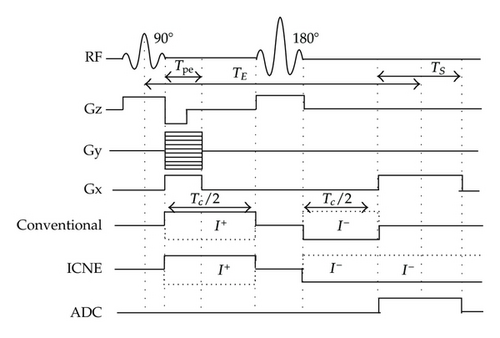
2.2. ICNE Bz Acquisition
Although the inversion is not uniquely solvable for Bz(x, y) in general, we can uniquely determine Bz(x, y) by assuming that φ(x): = x + Bz(x, y)/G is monotone increasing in the following theorem.
Theorem 2.1. Let ρ(x, y) have a finite support Ω. If Bz(x, y) is sufficiently small to guarantee that φ(x) = x + Bz(x, y)/G is monotone increasing so that φ′(x) > 0 for each y, then Bz(x, y) is uniquely recovered in Ω from ρ0(x, y) in (2.2) and SC(kx, ky) in (2.6).
Proof. We note that the linear encoding characteristic in the ky-variable remains unperturbed in (2.6). Thus, by one-dimensional inverse Fourier transform, SC in (2.6) is reduced to in the (kx, y)-hybrid space as the following:
By change of variables with φ(x), (2.7) is changed into
The relation (2.9) gives us the simple ordinary differential equation as follows:
By separation of variables, (2.11) and (2.14) lead us to
Remark 2.2. In Theorem 2.1, we assume that φ′(x) = 1 + (1/G)(∂Bz(x, y)/∂x) > 0. The magnetic flux density Bz is smooth and its intensity is 10−7 ~ 10−8 T in practical experimental environments. Furthermore, the usual range of the reading gradient G is 10−3 ~ 10−4 T/m. Thus, the assumption of φ′(x) > 0 is not severe in Theorem 2.1.
3. Discrete ICNE Inverse Problem
3.1. Newton Iterations
The previous method in [14, 15] was based on the Taylor approximation, but as a coincidental result, it can be interpreted as the first Newton iterate x1 in (3.9) with x0 = 0.
3.2. Convergence of Newton Iterations
Theorem 3.1. Let s(k) in (3.6) be made through (3.3) from b such that
Proof. Let . The condition (3.13) and Lemma 3.3 lead us to
For two constants in (3.17) and (3.21), let
Then, with the aid of the Theorem 6.14 in [17], F has a unique zero x⋆ in the ball
Lemma 3.2. If x, y ∈ ℝN, then
Proof. From (3.7), we expand
Since |eiθ − 1 | = 2 | sin (θ/2)|, we have for each k,
Lemma 3.3. For the trivial initial x0 = 0, one has
Proof. Since
From Lemma 3.4, we estimate that
Lemma 3.4. If θ is real, then
3.3. Norm of Inverse of Vandermonde Matrix
The norms of inverses of Vandermonde matrices were estimated by Gautschi [18, 19]. In some estimations there, the equality holds if all base points are on the same ray through the origin.
Compared to (3.31), for a small perturbation x, a bound of is investigated in the following lemma. Since the norm estimation of inverse of Vandermonde matrix must be interesting, we separate the result in this subsection from other ingredients for Theorem 3.1.
Lemma 3.5. If ∥x∥∞ < 1/4π(2 + log cot(π/2N)), then
Proof. Let I = [δkn] be the identity matrix and W = V(0) −1V(x) − I, whose entries are
Regarding summations of |Wkn|, the maximum occurs when k = N/2 ± 1 from the symmetry of the sine function in (3.37). In both cases, we have
4. Numerical Results
From the Biot-Savart law, we simulate the magnetic flux density Bz(n, m) induced by a horizontal current through the Logan shape ρ as in Figure 2, where N = 60. We obtain the simulated MR signals as depicted in Figure 3, through (3.1) with M = 32, δ = 0. We note that the maximum of Bz(n, m) is about 1/4 in Figure 2, larger than suggested in Theorem 3.1.
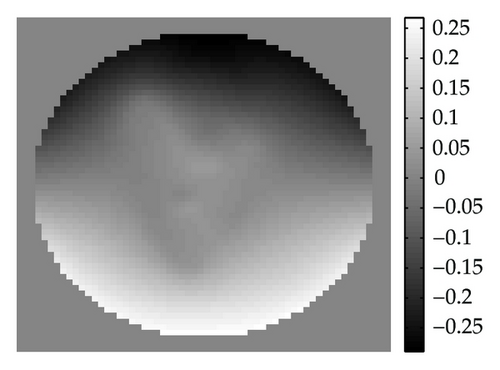
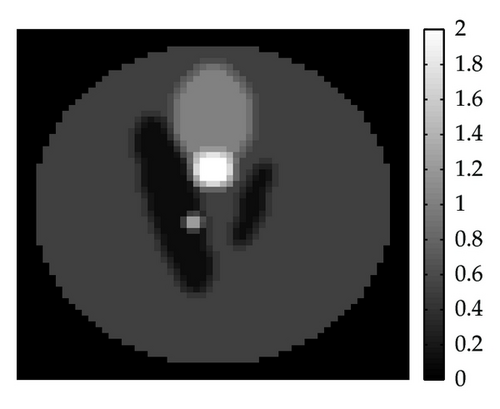
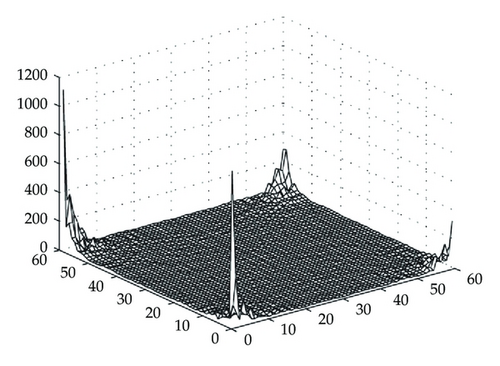
The log of error max n,m | Bz(n, m) − Bz(n, m) j| is given in Figure 4(a), which means that the error decay is quadratic. In the Newton iterations in (3.9), we have to solve a Vandermonde system for V(x), which may be consuming time or unstable. Instead of V(x) in (3.7), we can fix V(0) and simplify the Newton iterations in (3.9). Then, the error decay is reduced to be linear as in Figure 4(b).
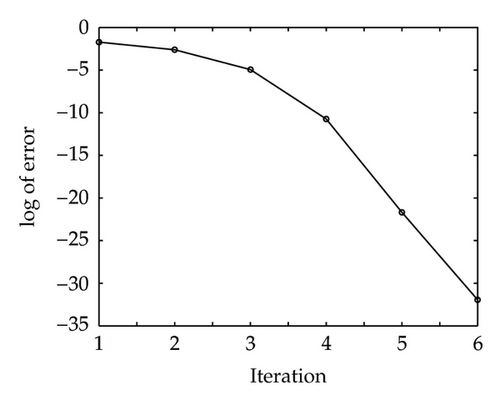
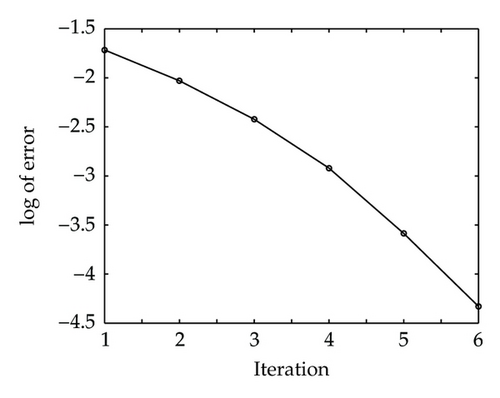
Acknowledgment
This paper was supported by Basic Science Research Program through the National Research Foundation of Korea (NRF) funded by the Ministry of Education, Science and Technology (2010-0022398, 2012R1A1A2009509).




